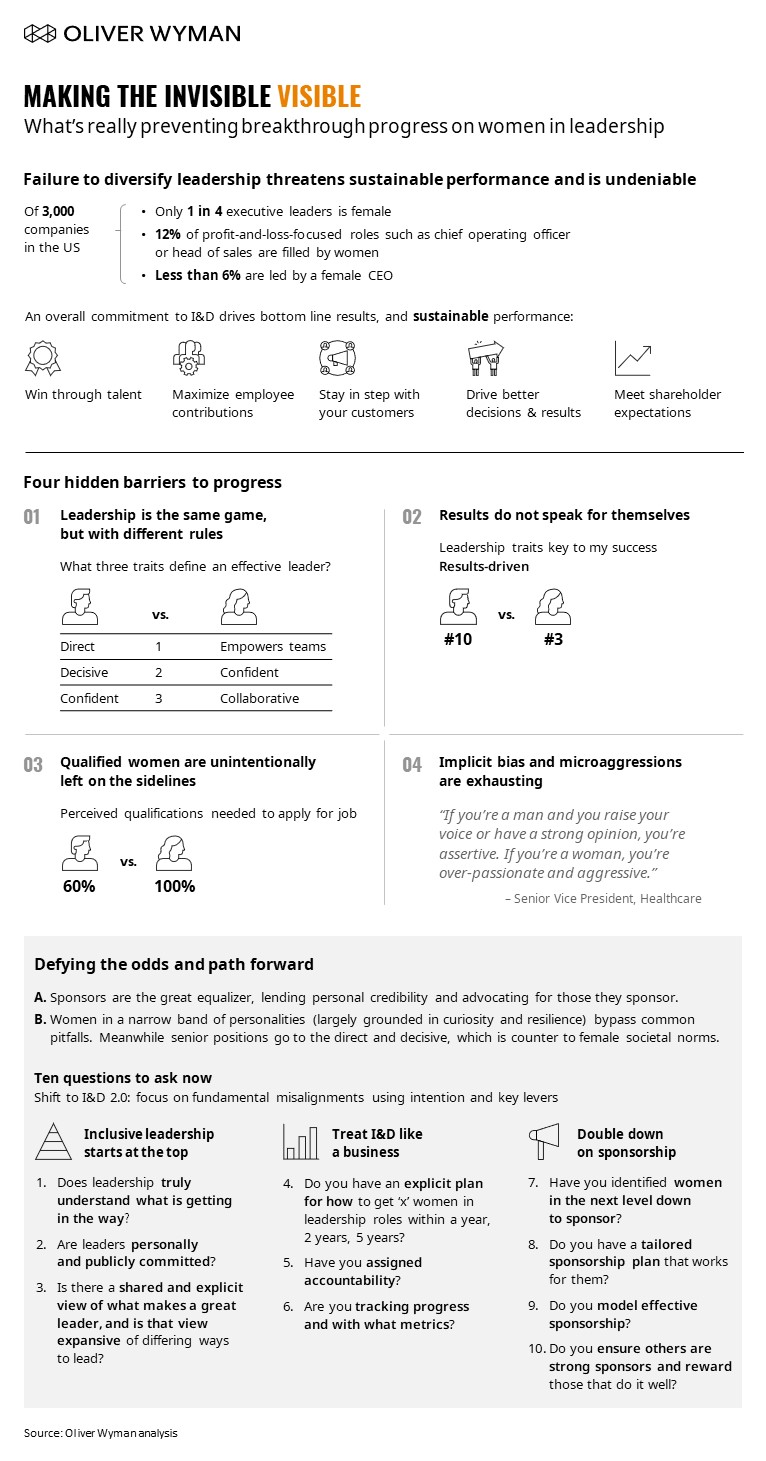Editor's Note: The following is an excerpt of our new research on what’s really preventing breakthrough progress on advancing women in leadership. Based on extensive interviews with over 160 C-Suite executives and a national survey of men and women, our research identifies the four hidden barriers that must be made more visible to all and outlines the three key levers to drive systemic and lasting change. Read the full report here: Making the Invisible Visible.
Making the Invisible Visible
Only one in four executive leaders is female
Companies recognize that diverse executive teams drive more innovation and better business outcomes, and in acknowledgment of that have been investing more in Inclusion and Diversity (I&D) initiatives.
Yet despite efforts to achieve C-suite gender diversity, diverse representation in senior leadership positions remains elusive: Only one in four executive leaders is female; across the top 3,000 companies in the United States, just 12 percent of profit-and-loss-focused roles such as chief operating officer or head of sales are filled by women; and fewer than six percent of these 3,000 companies are led by a female CEO.
Early in a career, individuals are evaluated based on functional capability and expertise — the hard skills and individual abilities needed to get things done. But as one rises through the ranks, the concept of “leadership skills” and getting things done by influencing others is what is being assessed. There is a lot less clarity and alignment on what defines effective leadership and individual potential, as those are far more subjective attributes to assess. Our research indicates a structural misalignment between men and women on what matters in terms of leadership and what it takes to advance into senior executive roles.
Combine this structural misalignment in perceptions of leadership with more subjectivity in assessing leadership skills and potential, and it’s no surprise that unconscious and implicit biases significantly affect the path of women to the top. Even if there was agreement on what “good” leadership looked like, businesses would still need to systematically address the issue of bias. Business cultures are still male-dominated because as the majority, they indirectly shape culture. Unconscious and implicit biases, therefore, affect the acceptable norms and unwritten rules of every interaction along the leadership journey. Our goal is to help executives understand what is getting in the way of women breaking into the C-Suite so you can directly address this within your organization. We want to shed light on these otherwise “hidden” challenges that get in the way and explain how companies can systemically make change happen faster.
Four hidden barriers getting in our way
Oliver Wyman researchers spoke with more than 160 senior female leaders in business and surveyed more than 300 male and female executives on the gender leadership gap. We uncovered four hidden barriers, each directly affecting a company’s ability to win through talent and build a sustainable culture for all.
1. Leadership is the same game with different rules
2. Results do not speak for themselves
3. Qualified women are unintentionally left on the sidelines
4. Implicit biases and microaggressions are exhausting
There was a regional opening and I said, “What about me?” My boss asked, “You would travel?” And I said, “Of course. Why would you think I wouldn’t?” I was shocked the reason I hadn’t been considered was travel. I ended up getting the job, but it just shows on the leadership journey, you have to speak up for yourself.
The path forward to breakthrough progress
The report dives into each of the barriers and provided fundamental steps to make real and lasting progress.
Make the invisible visible: Be not just aware of the hidden barriers but understand how and where they hijack everyone's best efforts. Only then can something be done about them.
Sponsorship, the great equalizer: Everyone who gets to senior leadership had sponsors who made a difference. Sponsors are more than mentors because they lend their own personal credibility and advocate for those they sponsor.
My sponsor is the reason I’m here — not because I haven’t earned my way, but because otherwise, I’d have hung out on the trading floor forever because I liked what I was doing and didn’t have the perspective to reach higher and for more.
Read the full report here: Making the Invisible Visible.




